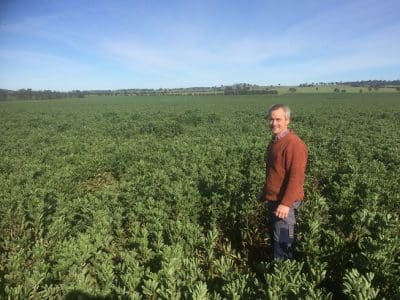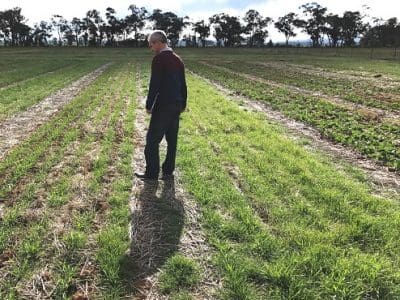Ask a WeedSmart Expert
THERE are many benefits associated with retaining stubble, but zero till seeding into high stubble loads can be problematic, particularly in wetter seasons.

CSIRO Agriculture and Food senior experimental scientist, Tony Swan, says crop sequence, including a double-break, is an effective way to manage weeds, improve profit and manage stubble residues in southern grain farming systems, with or without livestock.
CSIRO Agriculture and Food senior experimental scientist, Tony Swan, says growers can manage stubble without compromising weed, disease and pest management or the timeliness of the seeding operation.
“Decisions at harvest, post-harvest/pre-sowing and at sowing influence the success of a seeding operation into stubble,” he said.
“With a flexible approach, growers can manage stubble loads to suit their seeding operations, weed control tactics, herbicide choice and profit.
“As a rule of thumb, the stubble load after harvest is 1.5 to 2 times the grain yield for wheat and 2 to 3 times the grain yield for canola.
“A high stubble load can create issues for all types of seeding systems by restricting herbicide choice, effectiveness, contact on the soil or weed target and even reduce crop emergence.”
In 2014 an experiment was established at Temora, NSW in a paddock with high levels of Group B resistance in annual ryegrass.
The trial compared the yield, profit and annual ryegrass (ARG) population status in three management strategies in a no-till (tyne opener) or zero tilled (disc opener) farming system.

Tony Swan inspecting the stubble management trial plots, looking at the ‘Conservative (lower input)’ second year wheat treatment sown with a tyne seeder (left) compared to the ‘Conservative’ second year wheat treatment sown with a disc seeder where trifluralin could not be applied (not on label for disc seeders).
Introducing more crop and herbicide diversity into the farming system generated a higher average net margin over three years while reducing the seedbank from 1864 plants per square metre to 351 plants per square metre in just 24 months.
Following the wet 2016 season, with a soft late finish, three years of the diverse strategy (which included a double break) reduced the ryegrass seed bank by 70 per cent compared to the aggressive (high input) strategy (145 cf 573 seeds/m2), while the conservative (low input) strategy increased the seedbank by 600pc to above 4000 seeds/m2.
“Crop sequence is an effective way to manage weeds, improve profit and manage stubble residues in southern grain farming systems, with or without livestock,” Mr Swan said.
Does choice of seeder type influence weed control?
Short answer: In our experiment, after three years ARG seed numbers were generally lower when crops were sown with a tyne seeder.
Longer answer: Averaged across the three management strategies, ARG seedbank populations were lower in tyne seeded plots in 2016 (650 seeds/m2 in tyne cf 1080 seeds/m2 in disc) and 2017 (384 seeds/m2 in tyne cf 944 seeds/m2 in disc).
However, the use of expensive pre-emergent herbicides eliminated any significant difference in ARG seedbank populations in crops sown with a disc or tyned seeder.
In the conservative strategy where trifluralin cannot be used with a disc seeder (not on label), the result was a higher ARG seedbank population (4045 seeds/m2) with a disc seeder compared to 1840 seeds/m2 with a tyne seeder.
By February 2017, following the 2016 decile 9 season the lowest average ARG seedbank population was found in the diverse cropping strategy sown with a tyne seeder (82 seeds/m2).
In the conservative strategy weed populations continued to increase when sown with a tyne seeder (2322 seeds/m2) and with a disc seeder (7631 seeds/m2).
What options do I have if stubble is too thick to sow through?
Short answer: Reduce stubble load by grazing, baling, mulching, incorporating with nutrients, or use a strategic late burn.
Longer answer: Tyne seeding systems will struggle to establish crops into large stubble loads >6t/ha.
While disc seeders may penetrate the stubble more easily and plant crop seeds into high stubble loads, patchy crop establishment and ineffective herbicide application can result in any seeding system sown into high stubble loads.
Retaining stubble, with all its benefits, should not be allowed to compromise effective weed control.
Mulching, incorporation and grazing all potentially retain more nutrients in situ however mulching or incorporation are likely to lead to nutrient tie-up in the soil unless additional nutrients are added.
Grazing and late burning both improve in-crop nitrogen availability, and often the yield of the following crop.
It is not recommended to grow wheat after wheat unless the stubble from the first wheat crop is burnt or grazed, or supplementary nitrogen is applied to offset N immobilisation.
To try and avoid burning at all costs, the best option is to sow a diverse crop sequence and use the legume crop to reduce the cereal stubble.
Source: Weedsmart, https://weedsmart.org.au/
Mr Swan will be presenting his research into double-break cropping at the WeedSmart Forum on 21 August, in Wagga Wagga, NSW. Go to the website to register.
………………..
How to ask a WeedSmart question
Ask your questions about managing herbicide resistant weeds in high stubble situations on the WeedSmart Innovations Facebook page WeedSmartAU, Twitter @WeedSmartAU or the WeedSmart website http://www.weedsmart.org.au/category/ask-a-weedsmart-expert/
‘WeedSmart’ is an industry-led initiative that aims to enhance on-farm practices and promote the long term, sustainable use of herbicides in Australian agriculture.

HAVE YOUR SAY